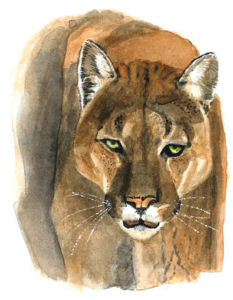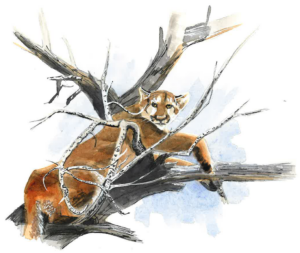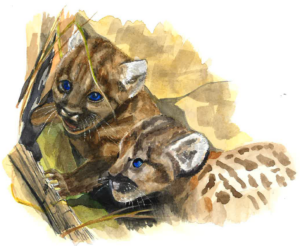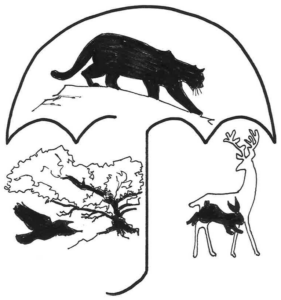Mountain lions are mammals with many names — they are called cougar, puma, or panther in our region.
Their scientific name is Puma concolor (concolor = one color). Their coloring is tan-light brown with whitish throat, belly, and inner legs. The tip of the tail, around their nose, and back of their ears are black. Their fur is short and coarse.
They are the biggest cat (and predator) in Boulder County. They vary in size and weight — they can be up to thirty inches at the shoulder. Males can weigh from 140 to as much as nearly 200 pounds, females weigh around 100 pounds. From nose to tail they can reach seven to eight feet (the tail is about the length of the body). They are considered an apex predator, which means they are at the top of the food chain with no natural predators.
Interesting Characteristics About Mountain Lions
Mountain lions don’t roar like other big cats; they chirp, growl, shriek and yes, even purr. They are crepuscular — meaning hunting in the dawn and twilight hours, and nocturnal — meaning active at night.
They are intelligent, shy and secretive; they prefer to be left alone.
Like other cats, they are curious.
They have exceptional sight, particularly beneficial for night hunting, and excellent hearing.
They can detect high frequency sounds that help them detect hidden prey.
Their sense of smell is not very good.
They are territorial — they mark their territory with urine and tree scratches.
They lead a solitary life — except during breeding time, which can be any time of the year.
They do not leave claw marks in their tracks like dogs. They can live up to 12 years in the wild.
Where do They Live?
Over half of Colorado is suitable habitat for mountain lions — including Boulder County and the Front Range. In 2021 Colorado Parks & Wildlife estimated there are between 3,800 and 7,000 mountain lions living in Colorado, many on the western side of the state, but there are a lot in Boulder County. The foothills and mountains are prime habitat with plentiful access to prey; there are also lots of hills, rock outcroppings and shrubs that give enough cover for hiding.
Mountain lions have a huge range — not only Colorado but across North and South America. They have the widest geographical range of any living mammal (besides humans of course) in North and South America.
These big cats are very adaptable and live in many ecosystems, from mountains to forests, deserts, and wetlands. As long as they have enough territory and access to shelter and prey, they adapt.
Strong, Powerful Hunters
Mountain lions are carnivorous, meaning they are meat eaters. They can’t survive on anything but meat. They need to eat large mammals in order to survive. They generally hunt elk and deer, and have been known to take moose, bighorn sheep, pronghorn, livestock, and many smaller animals in the absence of their preferred prey. As they share habitat with humans more and more, they also will go for small pets left unattended.
Mountain lions are super strong and fast. They have the largest legs proportionally in the feline family. They can run up to 50 miles per hour for short distances and can jump 19 feet straight up in the air, and leap 45 feet across land.
Mountain lions use a spot-and-stalk technique when hunting. They survey the land looking for unsuspecting prey. Exceptionally good at camouflage, they will see their prey before their prey sees them. Once they spot an animal — they begin to stalk it. They move in quietly so that they don’t alarm the animal. Once close enough, they pick up speed and pounce. They don’t want to waste energy and do long chases where they may tire and be unsuccessful in their hunt.
Mountain lions can consume 20-30 pounds of meat in a meal, caching their deceased prey. This means they bury it in ground litter to reduce scavenging by other animals and consume the remains over several days.
Family Life
Mountain lions breed year-round, giving birth every two years. Gestation (how long the female is pregnant before giving birth) is about 92 days, their litter size ranges from one-six, (typically they have two-three kittens), birth happens in June or July.
The young are born with blue eyes and spots; their eyes turn yellow within 16 months and the spots on their coat fade after six to nine months.
The mother leaves her young in a den (often a rock overhang or shallow cave) while she hunts to keep them safe from predators. The kittens begin to eat meat when they are around six weeks old.
The family (mother and kittens) leaves the den after about three months, traveling together from kill to kill.
Sub-adults leave mothers in spring, between 12-18 months old, maybe as long as 26 months old. Females may stay close; males generally go further away . . . sometimes hundreds of miles away, to establish their own territory.
Umbrella Species . . . What is That?
Mountain lions are considered an umbrella species. Their health as a species is dependent on large amounts of habitat. Mountain lions need about 13 times as much area as a black bear or 40 times as much as a bobcat to thrive. If there is enough prime habitat for mountain lions to thrive, this indicates many other plant and animal species that share the same habitat will be “under the umbrella” of mountain lions and will also benefit.
We may not see mountain lions very often, or ever, and that’s ok; but it’s nice to know they are out there, living their big cat lives. They are part of the balance and beauty of our wild spaces in Boulder County and beyond.
Continue Reading & Download the Print Edition
Nature Detectives Library
Every past issue of Nature Detectives can be found in the Nature Detectives Library!







